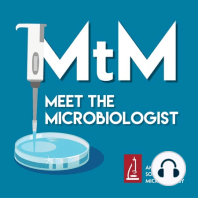15 min listen

072: Microbial diversity of natural ecosystems with Jennifer Martiny
072: Microbial diversity of natural ecosystems with Jennifer Martiny
ratings:
Length:
43 minutes
Released:
Dec 20, 2017
Format:
Podcast episode
Description
Jennifer Martiny describes the incredible microbial biodiversity of natural ecosystems such as soils and waterways. She explains how to add a bit of control in experiments with so many variables, and why categorizing microbial types is important for quantifying patterns. Host: Julie Wolf Subscribe (free) on iPhone, Android, RSS, or by email. You can also listen on your mobile device with the ASM Podcast app. Julie's biggest takeaways: Studying microbial community functions in their natural environment are harder to understand, but help us to parse the complexity of the natural world, in part because these experiments also include local flora and fauna that are often omitted in the controlled lab environment. Microbial cages - an actual physical barrier that contains a soil-based community - can help to disentangle the effects of the microbial community from those of the surrounding environment by adding a level of control by limiting interaction of microbes inside the nylon mesh cage with those outside of it. Are microbial functions redundant? It depends on what function you look at - respiration is a very common function, so it’s less likely to be affected by a change in microbiome composition. Other functions, such as degrading particular compounds, may have a stronger relationship between the microbes present and those functions. Microbes are hugely diverse! Jennifer’s comparison of all the diversity of the birds on Earth to a single bacterial taxon is mind-blowing! Microbial categorization may be hard, but the ability to group similar organisms is necessary to formulate hypotheses and conduct experiments. It’s important to remember the groupings are manmade and sometimes have to be reconstructed! Featured Quotes (in order of appearance) “One of the hardest things we study is not on the microbiology side but is on the ecosystem side, measuring those biochemical functions in the environment.” (10:05) “It’s not as if we are ever going to be able to study every particular organism out there and build a model with thousands of equations; instead what we really need to do is go after trade-offs and overall relationships that may hold across large groups, and in that way have some simple rules under different conditions like drought or temperature.” (16:45) "Modern birds evolved about 100, 125 million years ago. Two sequences that share the 16S gene, if it’s roughly 97% identical, probably diverged 150 million years ago. That means we are lumping in all the diversity within the bacteria group within one taxon, calling it a species, which is the equivalent of lumping all birds together!" (18:47) “It’s a bit overwhelming to imagine that for each 16S rRNA taxon, you could have as much functional, morphological, and behavioral diversity as what we see in all of birds!” (19:39) “In biology, we’re always using an operational definition but we don’t want to get too hung up on the definition and miss all the interesting patterns going on!” (20:49) “If you can start to quantify patterns, then you can start to ask ecological and even evolutionary questions about why we see those patterns.” (33:04) Links for this episode Jennifer Martiny Lab Home Page University of California Irvine Microbiome Initiative HOM Tidbit: TWIM 50: These things aren’t even bacteria! Carl Woese Obituary (New York Times) Carl Woese 1996 Feature (New York Times) Send your stories about our guests and/or your comments to jwolf@asmusa.org.
Released:
Dec 20, 2017
Format:
Podcast episode
Titles in the series (100)
MTS1 Ralph Tanner - The Future of Biofuels: Ralph Tanner, a professor of microbiology at the University of Oklahoma, focuses his research on anaerobes in the environment and putting those bacteria to use in industry. He develops useful microbial catalysts for biofuel production from sustainable cro by Meet the Microbiologist